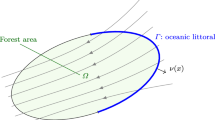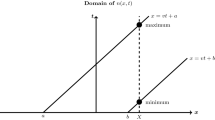Abstract
A simple mathematical model of mono-species forest with two age classes which takes into account seed production and dispersal is presented in the paper. This reaction — diffusion type model is then reduced by means of an asymptotic procedure to a lower dimensional reaction — cross-diffusion model. The existence of standing and travelling wave front solutions corresponding to the forest boundary is shown for the later model. On the basis of the analysis, possible changes in forest boundary dynamics caused by antropogenic impacts are discussed.
Similar content being viewed by others
References
Antonovsky, M. Ya.: Impact of the factors of the environment on the dynamics of populations (mathematical models). In: Comprehensive Analysis of the Environment. Proc. Soviet-American Symp., Tbilisi, March 25–29, 1974, pp. 218–230. Leningrad: Hydromet 1975
Antonovsky, M. Ya., Korzukhin, M. D.: Mathematical modelling of economic and ecological-economic processes. In: Integrated Global Monitoring of Environmental Pollution, Proc. 2nd International Symp., Tbilisi, USSR, 1981, pp. 353–358. Leningrad: Hydromet 1983
Antonovsky, M. Ya., Aponina, E. A., Kuznetsov, Yu. A.: Spatial-temporal structure of mixed-age forest boundary: The simplest mathematical model. WP-89–54. Laxenburg, Austria: International Institute for Applied Systems Analysis 1989
Antonovsky, M. Ya., Aponina, E. A., Kuznetsov, Yu. A.: On the stability analysis of the standing forest boundary, WP-91–010. Laxenburg, Austria: International Institute for Applied Systems Analysis 1991
Antonovsky, M. Ya., Fleming, R. A., Kuznetsov, Yu. A., Clark W. C.: Forest-pest interaction dynamics: The simplest mathematical models. Theor. Popul. Biol. 37, 343–357 (1990)
Berezovskaya, F. S., Karev, G. P., Shvidenko, A. Z.: Forest stand dynamics: Ecological-physiological approach (in Russian). Moscow: USSR State Forest Commity 1991
Friedman, M. J., Doedel, E. J.: Numerical computation and continuation of invariant manifolds connecting fixed points. SIAM J. Numer. Anal. 28, 789–808 (1991)
Gradshteyn, I. S., Ryzhik, I. M.: Table of Integrals, Series, and Products. New York London: Academic Press 1980
Henry, D.: Geometric Theory of Semilinear Parabolic Equations. (Lect. Notes Math., vol. 80) Berlin Heidelberg New York: Springer 1981
Korzukhin, M. D.: Age structure dynamics of three populations with high edification ability (in Russian). In: Problems of Ecological Monitoring and Ecosystems Modelling, vol. 3, pp. 162–178. Leningrad: Hydromet 1980
Kuznetsov, Yu. A.: Computation of invariant manifold bifurcations. In: Roose D. et al. (eds.) Continuation and Bifurcations: Numerical Techniques and Applications, pp. 183–195. The Netherlands: Kluwer 1990
Naiman, R. J., Decamps, H. (eds.): The Ecology and Management of Aquatic-Terrestrial Ecotones. (Man and the Biosphere, vol. 4) Carnforth: Parthenon 1990
Okubo, A., Levin, S. A.: A theoretical framework for data analysis of wind dispersal of seeds and pollen. Ecology 70(2), 329–338 (1989)
Prentice, I. C., et al.: Developing a Global Vegetation Dynamics Model: Results of IIASA Summer Workshop. RR-89–7. Laxenburg, Austria: International Institute for Applied Systems Analysis 1989
Samarskaya, E. A.: Forest-pest interaction dynamics in temporal and spatial domains. WP-89–16. Laxenburg, Austria: International Institute for Applied Systems Analysis 1989
Silvertown, J. W.: Introduction to Plant Population Ecology. London New York: Longman 1982
Shugart, H.: Theory of Forest Dynamics: The Ecological Implications of Forest Succession Models. Berlin Heidelberg New York: Springer 1984
Author information
Authors and Affiliations
Rights and permissions
About this article
Cite this article
Kuznetsov, Y.A., Antonovsky, M.Y., Biktashev, V.N. et al. A cross-diffusion model of forest boundary dynamics. J. Math. Biol. 32, 219–232 (1994). https://doi.org/10.1007/BF00163879
Received:
Revised:
Issue Date:
DOI: https://doi.org/10.1007/BF00163879




